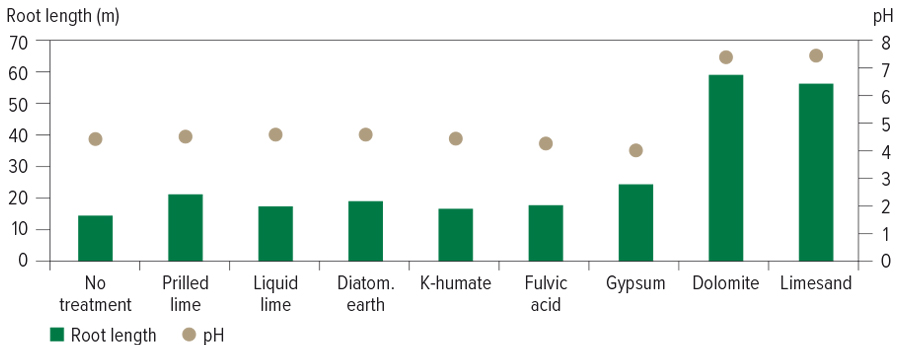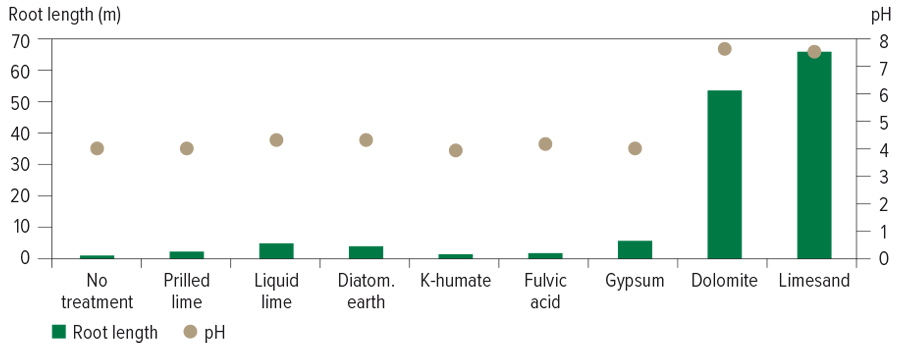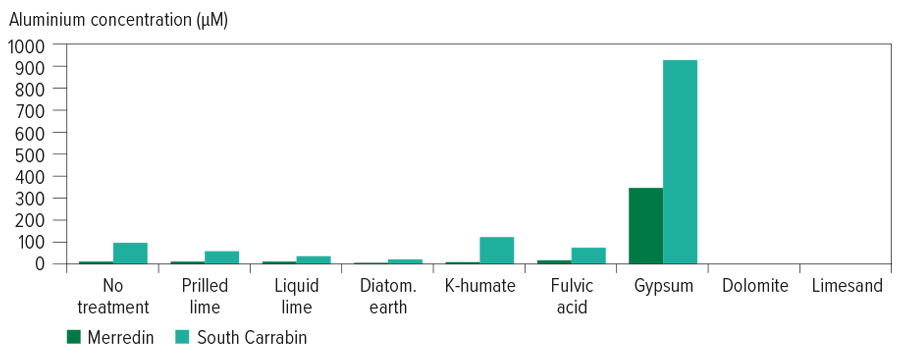The cost of transporting lime, particularly to areas far from lime sources, as well as slow reaction time, is motivation for many growers to seek alternative lime options, including on-farm lime sources.
Glasshouse research has compared various commercially available lime sources and alternative lime products for their effect on root growth, aluminium toxicity and soil pH. The benefit of glasshouse research is being able to tease out product effects from environmental factors.
The products were applied at ‘low’ and ‘high’ rates to two soils (Merredin and South Carrabin, Western Australia) by:
- Banding in topsoil (at about four centimetres), with fertiliser and below the seed, at a low rate.
- Mixing thoroughly through the topsoil at a high rate.
- Banding in the subsoil (at about six centimetres depth) at a low rate.
- Mixing thoroughly through the upper 5cm of the subsoil (from 5 to 9cm depth) at a high rate.
‘Low’ rates were based on manufacturers’ recommendations, or limited previous trials. ‘High’ rates were typically five to 10 times greater than the low rates and were deemed to represent the maximum rate of product that might be applied to soil due to logistical or economic constraints (Damon et al. 2016).
Results
Root length in subsoil
Mixing the high rate of lime into the subsoil made the most significant difference. Root lengths with limesand and dolomite were two to three times higher than with the other products in the Merredin soil, and up to 10 times higher in the South Carrabin soil. The other products were not significantly different to applying nothing (see Figures 1 and 2).
Adding liming products to the topsoil had minimal effect on root length in the subsoil. Mixing the high rate into the topsoil improved root growth with limesand and dolomite, while other products were not significantly different to the control. Banding the low rate in the topsoil had the least impact.
pH and aluminium toxicity in subsoil
As with root growth, mixing the various liming products into the subsoil had the most impact on soil pH and aluminium toxicity. However, while limesand and dolomite saw statistically significant improvements in pH, subsoil pH remained similar to the control for the other liming products at about 4.5 for Merredin soil and 4.0 for South Carrabin (see Figures 1 and 2). Gypsum significantly lowered the pH of the soil solution.
Limesand and dolomite removed the most aluminium from soil solution at both sites (see Figure 3). Gypsum caused the largest increase in aluminium concentration in the subsoil. However, there was no effect on root growth which may be because gypsum can reduce the relative reactivity of aluminium and therefore toxic effects on roots. Other liming products had smaller, statistically insignificant effects on pH and aluminium.
Conclusion
Limesand and dolomite outperformed lime alternatives to improve root growth, neutralise acidity and reduce aluminium toxicity. When choosing lime sources, it is critical to evaluate their usefulness by considering cost, rate, particle size and neutralising value.
More information: Paul Damon, paul.damon@uwa.edu.au
This article was produced as part of the GRDC ‘Maintain the longevity of soils constraints investments and increase grower adoption through extension – western region’ investment (PLT1909-001SAX). This project is extending practical findings to grain growers from the five-year Soil Constraints – West suite of projects, conducted by the Department of Primary Industries and Regional Development (DPIRD), with GRDC investment.
References
Damon PM, Rengel Z, Gazey C, Azam G, Scanlan C, Sarre G, Malinowski D, Xi XY. 2016.
Evaluating novel materials to ameliorate aluminium toxicity in acidic subsoils: a glasshouse study. Final report for ‘Innovative approaches to managing subsoil acidity’.
Figure 1: Root length and subsoil pH (Merredin).

Source: Paul Damon, UWA
Figure 2: Root length and subsoil pH (South Carrabin).

Source: Paul Damon, UWA
Figure 3: Subsoil aluminium concentration.

Source: Paul Damon, UWA

























































